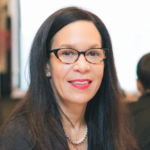For years, we have been hearing about the impact of purpose on people’s lives. It leads to greater longevity and better health — specifically, reduced risk of stroke and heart attack — as those with a sense of purpose tend to seek preventative care.
In his book “Being Mortal,” Dr. Atul Gawande tells the now well-known story of geriatrician Dr. Bill Thomas bringing animals into a nursing home — to stay. Two dogs. Four cats. Plants and parakeets in every room. What was the result? Drug dosages decreased. Nonverbal residents started speaking. And one man who had lost the will to live found his purpose in walking the dogs.
As Thomas strove to combat what he called the “three plagues of nursing home existence: boredom, loneliness and helplessness,” the result was a newfound sense of purpose for the residents and the staff.
When I reflect on the power of purpose, I immediately think of an elderly woman named Rita. She was living with her daughter, herself a single mother, in Orlando, FL, and as much as Rita wanted to make some changes to improve her health state, she simply couldn’t find the motivation. She was spending most of the day indoors and was barely eating enough, making her frail and weak.
From my work at AARP, I knew we needed to drill down into purpose. But you can’t just ask someone, “Excuse me, what’s your purpose?” Who has a ready answer?
Fortunately, I was familiar with the purpose-defining process Richard Leider had brought to AARP, and I brought her through the steps. We began by identifying the gifts she brought to the world, moved onto what she was passionate about, explored the impact she wanted to make, then brought it back to what she valued.
So, what was really important to her? Family. Her daughter was going on a vacation to Las Vegas, and she wanted to be well enough to go. That’s all it took! She found the motivation to go on daily walks and to eat healthy meals. Her new habits really seemed to improve her mood, not to mention her outlook.
This conversation took place as I was assisting with a pilot program to help older adults age at home, although it’s applicable to residential senior living as well. For the sake of efficiency, most senior living is one-size-fits-all, but that model simply doesn’t work any longer, especially as the aging baby boomer population is looking for personalized solutions.
Instead, take residents through this process to identify their purpose using Gifts, Passions, Impacts, and Values, or GPIV. What we’ve learned is that it’s difficult for someone to name their gifts if they’re starting with a blank slate, so it’s good to have options to choose from.
Whether you create a tablet-friendly app or simply get out some paper and pencil, it’s a valuable activity for everyone (probably even the staff). When these elements are brought together, what you have is a purpose statement — a powerful tool, and, in the best-case-scenario, a driving force.
I know that engaging in this exercise may sound like one more thing to do, but we also have to face the fact that occupancy in senior living is in question, which makes staying competitive all the more important. For instance, many baby boomers are flocking to Margaritaville. Why is that? Perhaps because it matches up with people’s passions and values — to be social, to experience ease and play. We’re not immortal, but who wants to focus on a future of decline?
You don’t need parakeets in every room, but you do need to know your residents and design programs based on their sense of purpose. Perhaps your seniors want to engage with the local community to mentor youth or share their wisdom. Perhaps they want the fun and excitement of heading into town for dinner. If you make your activity calendar without fully understanding the individuals in your care, it’s simply guesswork, and sometimes it can be costly.
Once you’ve engaged your residents in a GPIV exercise to arrive at their purpose statement, it’s best to come up with some goals and choose one to focus on.
According to B.J. Fogg, a Stanford researcher on behavior change, you need to break things down into tiny steps.
For instance, Rita’s big goal of getting to Vegas was laudable, but at the time she set that goal, she couldn’t get out of the house. So, we broke it down into its component parts: Take a walk during every companion visit. Start eating the healthy meals we were delivering to her. Each time she did one of these, there was something to celebrate and something to live for.
Rita found the whole process exhilarating. And wouldn’t you believe it? Six months later she was on a plane to Vegas. Not in a wheelchair, but on her own two feet.
Ultimately, there are many creative ways to distinguish your brand, and these are just a few examples. Whether you blend purpose with technology is up to you, but know this: Contrary to popular opinion, plenty of older adults can work a tablet, and baby boomers, who represent the future of senior living, are quite tech-savvy. As such, it’s time to get creative with the ways that technology can offer a personalized experience.
Wishing everyone in the industry fruitful exploration in the days, months and years to come — for innovation isn’t a one-time thing; it’s a constant.




